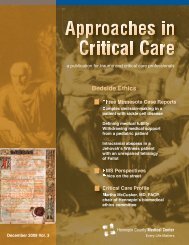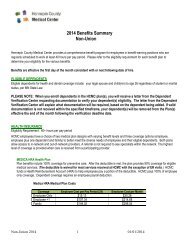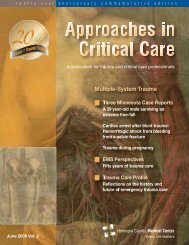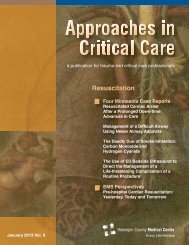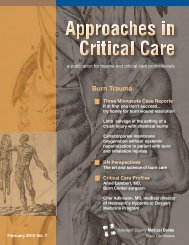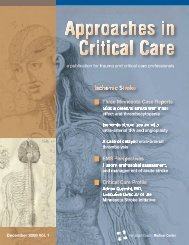Pediatric Trauma - Hennepin County Medical Center
Pediatric Trauma - Hennepin County Medical Center
Pediatric Trauma - Hennepin County Medical Center
Create successful ePaper yourself
Turn your PDF publications into a flip-book with our unique Google optimized e-Paper software.
Case Reports<br />
Grade<br />
Injury Description<br />
I<br />
II<br />
III<br />
IV<br />
V<br />
Hematoma<br />
Laceration<br />
Hematoma<br />
Laceration<br />
Laceration<br />
Laceration<br />
Hematoma<br />
Laceration<br />
Contusion with microscopic hematuria, urologic studies normal<br />
Non-expanding subcapsular hematoma without parenchymal laceration<br />
Non-expanding peri-renal hematoma confined to renal retroperitoneum<br />
< 1.0 cm parenchymal depth of renal cortex without urinary extravasation<br />
Laceration > 1.0 cm parenchymal depth of renal cortex without collecting system<br />
rupture or urinary extravasation<br />
Parenchymal laceration extending through renal cortex, medulla, and collecting<br />
system with urinary extravasation; injury to main renal artery or vein with<br />
contained hemorrhage<br />
Massive disruption of the duodenopancreatic complex<br />
Devascularization of the duodenum<br />
Table One.<br />
Organ Injury<br />
Scale American<br />
Association for<br />
the Surgery of<br />
<strong>Trauma</strong>: Kidney 3<br />
With these findings, a left nephrectomy was<br />
performed. Given the proximity of the small bowel<br />
and duodenal injury, a partial duodenectomy and<br />
small bowel resection were performed to include the<br />
distal portion of the third portion of the duodenum, the<br />
fourth portion of the duodenum, and the involved<br />
small bowel. This was reconstructed by mobilizing the<br />
remaining third portion of the duodenum and then<br />
creation of a small bowel to duodenal anastomosis<br />
with a partially stapled, partially hand-sewn technique.<br />
An incidental appendectomy was also performed.<br />
The retroperitoneum continued to have a small but<br />
steady amount of bleeding. This was packed. A<br />
temporary abdominal closure was then performed<br />
with a planned second-look laparotomy in 36 hours.<br />
The patient was then transferred to the PICU.<br />
With the assistance of the pediatric intensivists, the<br />
patient received ongoing fluid resuscitation. Postoperatively,<br />
he remained intubated and sedated. The<br />
patient was taken back to the OR on post-operative<br />
day two. The transverse colon serosal tear was<br />
primarily repaired. The bleeding from the retroperitoneum<br />
had stopped. The duodenal small bowel anastomosis<br />
was inspected and found to be intact and well perfused.<br />
His abdomen was definitively closed. His NG tube<br />
was left in place. He was transferred back to the<br />
PICU and was extubated later that day.<br />
This patient did well postoperatively. His nasogastric<br />
tube was removed on hospital day seven. On hospital<br />
day eight, the nasogastric tube was replaced after an<br />
episode of bilious emesis. A CT scan with PO and IV<br />
contrast was obtained. This showed no leak, but<br />
some edema in the third portion of the duodenum, as<br />
well as a fluid collection within the left renal fossa.<br />
The nasogastric tube was removed on hospital day<br />
11. The patient was discharged to home on hospital<br />
day 16. His peak creatinine during his hospital stay<br />
was 0.9.<br />
Discussion<br />
Renal Injury<br />
Nephrectomy for trauma in children is a rare event;<br />
even in high grade injuries. 1 Indications for nephrectomy<br />
include hemodynamic instability despite fluid resuscitation<br />
from ongoing hemorrhage and uncontrolled sepsis.<br />
Nephrectomy for an ischemic kidney from renal artery<br />
thrombosis is recommended if a laparotomy is being<br />
performed for another reason, i.e. hemorrhage,<br />
suspected bowel injury, etc. Childrenʼs National<br />
<strong>Medical</strong> <strong>Center</strong> reviewed its experience with blunt<br />
renal injury in children. 2 This was a single center<br />
retrospective review that included 126 children. Sixty<br />
percent of the patients had a low-grade injury, defined<br />
as American Association for Surgery in <strong>Trauma</strong><br />
(AAST) Grade 1, 2, or 3 level of injury. The remaining<br />
40% suffered an AAST Grade 4 or 5 injuries. Only<br />
four patients (3.2%) required nephrectomy and only<br />
two (1.6%) required immediate surgical intervention.<br />
Childrenʼs National <strong>Medical</strong> <strong>Center</strong> concluded that<br />
initial non-surgical management of high-grade renal<br />
trauma is recommended for hemodynamically stable<br />
children. The AAST renal injury grading definitions are<br />
given in Table One. In a 12-year retrospective series<br />
from Baltimore of 79 patients ages 2-14 with renal<br />
injury, 25% were Grade 4 or 5 injuries. 5 Seven (8.8%)<br />
required nephrectomy, all of whom had Grade 5<br />
injuries. Children who undergo conservative<br />
management of renal injuries appear to have good<br />
renal function in short- and long-term follow- up. 6 In a<br />
series of 16 patients (12 of whom had high-grade<br />
injuries) who were followed for one year post-injury,<br />
all of the children had normal BUN, creatinine, and<br />
blood pressure.<br />
Current recommendations from the American<br />
Academy of <strong>Pediatric</strong>s regarding children with an<br />
absence of a kidney and participation in contact<br />
sports emphasizes the need for clinical judgment and<br />
individual assessment of both the patient and the<br />
contact sport in question. 7 Several studies have<br />
highlighted that the risk of renal loss from contact<br />
sports is rare. 1<br />
6 | Approaches in Critical Care | June 2011




